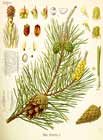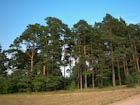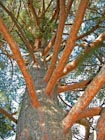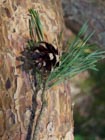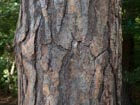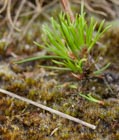Pinus sylvestris
Linnaeus 1753, p. 1000
Common names
Scots pine; pin royo [Aragonese]; meşə şamı [Azerbaijani]; Хвоя звычайная [Belarussian]; Бял бор [Bulgarian]; pi roig [Catalan]; 歐洲赤松 [Chinese]; Хыр [Chuvash]; obični bor [Croatian]; borovice lesní [Czech]; skovfyr [Danish]; grove den [Dutch]; harilik mänd [Estonian]; mänty [Finnish]; pin sauvage [French]; piñeiro rubio [Galician]; waldkiefer [German]; erdeifenyő [Hungarian]; pino silvestre [Italian]; parastā priede [Latvian]; paprastoji pušis, pošės [Lithuanian]; furu [Norwegian]; sosna zwyczajna [Polish]; pinheiro-da-escócia [Portuguese]; pin de pădure [Romanian]; Сосна обыкновенная [Russian]; beahci [Sami]; beli bor [Serbian]; borovica sosnová [Slovakian]; rdeči bor [Slovene]; pino silvestre [Spanish]; tall [Swedish]; sarıçam [Turkish]; Сосна звичайна [Ukrainian]. The term 'Scotch' pine is incorrect and should not be used, as these trees are not a source of that celebrated intoxicant.
Taxonomic notes
This is the type species of Pinus Section Pinus Subsection Pinus. Certainly Linnaeus saw it as the first pine, but the Romans, for whom Pinus was the common name for "pine", may have been thinking more of Pinus pinea.
There are two named nothospecies. Pinus × neilreichiana is the natural hybrid of P. sylvestris with P. nigra subsp. nigra, described on the latter page. P. × rhaetica is the hybrid of P. sylvestris with P. mugo.
Despite its huge range, P. sylvestris is remarkably uniform in its morphology with individual variation within populations much greater than between-population variation. Over 140 subspecies, varieties and forms have been described in on orgy of botanical nationalism, but only the type, var. sylvestris, var. hamata C. Steven (= subsp. hamata (Steven) Fomin), and var. mongolica Litvinov (= subsp. kulundensis Sukaczev) are now normally accepted (Farjon 1998); even these are barely distinguishable from each other.
Far northern trees, north of about 65°N, were formerly treated as var. lapponica Hartm. but are now thought to represent polyphyletic colonization and adaptations to harsh environments across a very broad front; the variation is continuous and clinal, with no population definable (Langlet 1959), and the variety is no longer accepted (Langlet 1959, Farjon 1998).
Trees from the extreme west of the range, in NW Scotland (Loch Maree area, Wester Ross), and presumably also the now-extinct Irish populations, show resin chemistry and adaptations to oceanic climates not found in the rest of the species' range. These trees are thought to have survived the ice ages on nunataks off NW Ireland and/or W Scotland, or are possibly derived from Spanish populations (Forrest 1980, 1982; Kinloch et al. 1986); as yet there has been no research as to whether this small endangered population deserves taxonomic recognition. Trees from the rest of Scotland (sometimes treated as var. scotica Schott) by contrast showed very close similarity to typical S Swedish / N German origins (Forrest 1980, 1982; Kinloch et al. 1986) and probably colonized across the (then dry) North Sea basin.
Spanish populations, sometimes treated as var. nevadensis H. Christ or var. iberica Svoboda, are genetically distinct (Prus-Glowacki & Stephan 1994) and deserve further taxonomic investigation with possible future varietal or subspecific recognition.
Description
A tree to 25–40 m tall and 0.5–1.2 m dbh. Stem straight (contorted only if lead shoot damaged when young, often by pine shoot moth Evetria turionana). The crown is variable, with a variety of shapes common in wild populations from level branches to near-fastigiate (Pravdin 1964, Steven & Carlisle 1959); open ovoid-conic when young and usually eventually becoming dense, broadly domed or even flat-topped. Bark on lower stem thick, scaly-plated, grey-brown; on upper stem and branches, thin, flaking, orange-red. Branching uninodal. Shoots green at first, becoming grey-buff by the end of the first summer. Buds ovoid-conic, orange-brown, thinly to occasionally thickly covered in white resin. Leaves in fascicles of two, (2.5–)4–6(–9) cm long, 1.5–2 mm wide, always moderately to often strongly glaucous (the only two-leaved hard pine with blue-green or grey-green leaves—an easy pine to identify), longest on vigorous young trees (5–9 cm), short on old trees (2.5–5 cm), commonly slightly twisted, margins finely serrulate; persistent for 2–6(–9) years; leaf sheath grey, 5–8 mm, slowly eroding to 3–4 mm by leaf senescence. Male cones 8–12 mm, yellow or pink. Cones (2.5–)3–6(–7.5) cm long, conic, symmetrical or nearly so, green ripening matt grey-buff to grey-green; mature in November–December, 20 months after pollination, opening February–April and falling soon after seed shed; scales rhombic, flat to protuberant and (rarely) hooked (with a full range of variation inbetween), with a minutely mucronate dorsal umbo. Seeds black, 4–5 mm, with a 12–20 mm wing (Pravdin 1964, Steven and Carlisle 1959; M.P. Frankis pers. obs.).
Var. hamata differs mainly in resin chemistry (Mirov 1967). It also tends to have more pronounced hooked apophyses than the type usually does, but there is much overlap. The leaves stay a stronger blue-green in winter than the type (which often turns drab green in winter).
Var. mongolica differs in having buds more thickly coated in resin, but not all trees show this, and thickly resinous buds can also occur on the type. The foliage tends to be duller, less bluish and more grey-green, to even yellow-grey in winter.
Var. lapponica is sometimes distinguished on the basis of shorter and longer-persistent leaves (5-9 years), but its characters overlap and intergrade to such a large extent that it cannot be adequately defined.
Distribution and Ecology
This is the world's most widespread conifer, after Juniperus communis, and its native range includes Albania, Andorra, Armenia, Austria, Azerbaijan, Belarus, Bosnia & Herzegovina, Bulgaria, China, Croatia, Czech Republic, Estonia, Finland, France, Georgia, Germany, Greece, Hungary, Italy, Kazakhstan, Latvia, Lithuania, Macedonia, Mongolia, Montenegro, Norway, Poland, Portugal, Romania, Russia, Serbia, Slovakia, Slovenia, Spain, Sweden, Switzerland, Turkey, Ukraine, and the United Kingdom. Naturalized and exterminated but reintroduced extent is discussed below.
Var. sylvestris occurs in Europe, from Scotland and Spain eastward, and across N Asia nearly to the Pacific coast. In N Eurasia, from sea level to 1,000 m; in S Europe only above 500 m in mountains, to as high as 2,400 m in Spanish Sierra Nevada. Absent from E coastal parts of Siberia, rare and local in NE Siberia (Dinets 1998). Native to Croatia. USDA hardiness zone 1-4, depending on origin; Spanish and NW Scottish origins probably zone 6-7. Extinct through human agency (felling, burning, overgrazing) in Ireland, Wales, England, Netherlands and Denmark; re-introduced populations (largely of unknown derivation) thriving locally in all these countries. Naturalized in Canada: Alberta, British Columbia, Manitoba, New Brunswick, Newfoundland, Nova Scotia, Ontario, Prince Edward Island, and Québec; and the USA: Connecticut, Delaware, Iowa, Illinois, Indiana, Maine, Maryland, Massachusetts, Michigan, Minnesota, New Hampshire, New Jersey, New York, Ohio, Pennsylvania, Rhode Island, Vermont, and Wisconsin (PLANTS database 2009.03.31).
Var. hamata is native to the Balkan peninsula, N Turkey and SW Transcaucasia (Dinets 1998), at altitudes of 500–2,600 m (Mirov 1967). USDA hardiness zone 6.
Var. lapponica is often cited as native to Norway, Sweden, Finland, and adjacent parts of Russia north of 65°N (Dinets 1998, Silba 1986). It grows to about 30 m tall on the Solovki Islands in the White Sea (Vladimir Dinets e-mail 1998.01.10).
Var. mongolica is native to Mongolia, NW China, & S. Siberia, at 300-2000 m altitude. It "[o]ccupies great areas in Transbaikalia, in most other areas prefers dry slopes or sandy soils, pure or with Larix spp. ('white taiga')" A specimen 42 m tall is known in the Sohondo Nat. Res., Transbaikalia (Vladimir Dinets e-mail 1998.01.10). USDA hardiness zone 2.
Remarkable Specimens
"The thickest Swedish pine has a girth of 4.49 m and is growing at Strängsered in Ulricehamn" (Anonymous [no date]). The tallest specimens, up to 45–50 m high, occur along the S coast of the Baltic Sea (Vladimir Dinets e-mail 1998.01.10). The stoutest in the UK is 169 cm dbh, at Belladrum, Scottish Highlands (A.F. Mitchell).
There are abundant age data for this species. The oldest record was recovered from a log sampled at a sawmill in Albania; it provided a 1017-year record, from 968 to 1984 (Seim et al. 2012). The oldest known living tree is growing in Lapland (Finland), less than a kilometer from the Russian border. Researcher Tuomo Wallenius sampled and crossdated the tree, finding an oldest ring date of 1244, i.e., 764 years old when sampled in 2007 (Finnish Forest Research Institute 2007).
Ethnobotany
Commonly sold as a Christmas tree, mainly in N America but also now in Britain, though not the traditional species for this use; when so used, var. hamata is the best as it has better blue colour in winter. An important timber species throughout much of its range.
Also see Mythology and Folklore of the Scots Pine (off-site link).
This is one of two pines I have heard of, where people used to eat the bark (the other is Pinus ponderosa). The outer bark would be stripped, and then the cambium and phloem scraped off; these contain a small proportion of proteins, fats, and digestible carbohydrates, as well as vitamin C. The bark mostly consists of indigestible cellulose, and the taste is generally described as unpleasant, so it is primarily eaten in times of famine. With Pinus sylvestris, the harvested inner bark would be ground to powder and baked with normal (wheat) flour to make bark bread. This practice was particularly recorded among the Sami people (sources cited by Wikipedia, accessed 2023.12.16).
A 1999 search produced 366 papers in dendrochronology involving Pinus sylvestris. There were over a hundred citations involving problems in archeology and a like number involving climate studies. The species has been used to develop a continuous tree-ring chronology extending from 5634 BC to the present (Helama et al. 2008). It has also been used in studies of stand dynamics, air pollution (including Chernobyl radiation), ecophysiology, and a host of more arcane studies. The bibliography has doubtless grown greatly since then; few, if any species have been more extensively used in dendrochronology.
Observations
In Scotland, see the page on How to find the main pine forest remnants, which provides directions on how to reach the nine best examples of remnant Scots pine forest.
Remarks
The epithet sylvestris means "of the forest".
Trees naturalised or planted in N America commonly show a contorted stem form (Kral 1993), possibly due to introduced insect pests lacking their normal control predators and parasites. In its native areas, stem straightness is usually very good.
Var. nevadensis (native to Spain) is listed as vulnerable on the 1996 IUCN Red List.
Citations
Anonymous. [no date]. Forest Sweden: The Swedish Forests. http://www-forest.slu.se/skogen/eng/omtrad.cfm, accessed 1999.06.05.
Finnish Forest Research Institute (Metla). 2007.08.06. Lapista löytyi ennätysvanha mänty. http://www.metla.fi/tiedotteet/2007/2007-08-06-vanhin-puu.htm, accessed 2011.02.23 [in Finnish].
Forrest, G. I. 1980. Genotypic variation among native Scots Pine populations in Scotland based on monoterpene analysis. Forestry 53: 101-128.
Forrest, G. I. 1982. Relationship of some European Scots Pine populations to native Scottish woodlands based on monoterpene analysis. Forestry 55: 19-37.
Gutiérrez, E. 1989. Dendroclimatological study of Pinus sylvestris L. in southern Catalonia (Spain). Tree-Ring Bulletin 49:1-9.
Helama, S, K. Mielikäinen, M. Timonen, and M. Eronen. 2008. Finnish supralong tree-ring chronology extended to 5634 BC. Norsk Geografisk Tidsskrift / Norwegian Journal of Geography 62:271-277.
Kinloch, B. B., R. D. Westfall & G. I. Forrest 1986. Caledonian Scots Pine: origins and genetic structure. New Phytologist 104: 703-729.
Langlet, O. 1959. A cline or not a cline—a question of Scots Pine. Silvae Genetica 8: 13-22.
Pravdin, L. F. 1964. Sosna obyknovennaya. Izdatel'stvo Nauka, Moskva [Translated Israel progr. scient. transl., Jerusalem, as Scots Pine, 1969].
Prus-Glowacki, W. & B. R. Stephan 1994. Genetic variation of Pinus sylvestris from Spain in relation to other European populations. Silvae Genetica 43: 7-14.
Seim, Andrea, Ulf Büntgen, Patrick Fonti, Hajri Haska, Franz Herzig, Willy Tegel, Valerie Trouet, and Kerstin Treydte. 2012. Climate sensitivity of a millennium-long pine chronology from Albania. Climate Research 51:217-228.
Steven, H. M. & A. Carlisle 1959. The native pinewoods of Scotland.
An early version of this page was prepared 1999.01.02 by Michael P. Frankis.
See also
Burns and Honkala (1990).
Elwes and Henry 1906-1913 at the Biodiversity Heritage Library. This series of volumes, privately printed, provides some of the most engaging descriptions of conifers ever published. Although they only treat species cultivated in the U.K. and Ireland, and the taxonomy is a bit dated, still these accounts are thorough, treating such topics as species description, range, varieties, exceptionally old or tall specimens, remarkable trees, and cultivation. Despite being over a century old, they are generally accurate, and are illustrated with some remarkable photographs and lithographs.
The FEIS database.
Things you never knew about Scots pine, accessed 2009.03.28. Very informative page with many good photographs.
